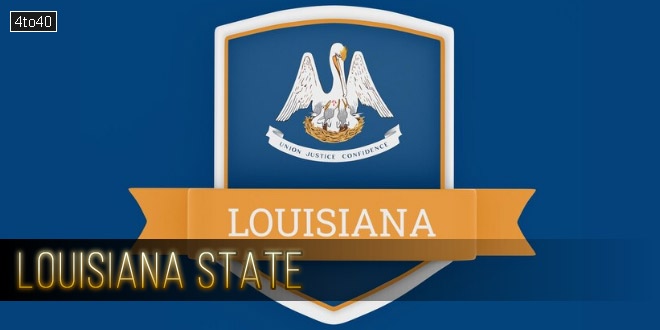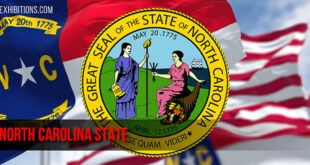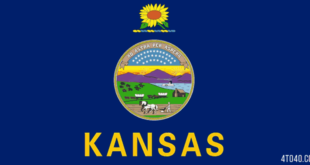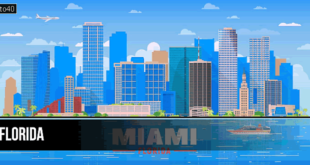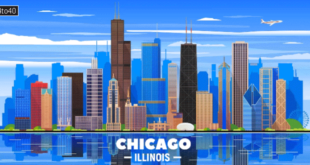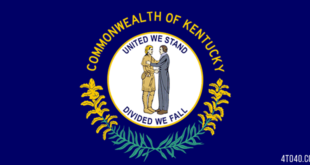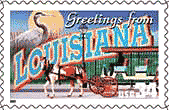 Louisiana, located in the southeastern United States, Louisiana lies entirely within the Gulf Coastal Plain. It is shaped like a capital L, approximately 530 km (330 mi) at its widest, and about 450 km (280 mi) from north to south. Louisiana is bordered by Mississippi on the east, the Gulf of Mexico on the south, Texas on the west, and Arkansas on the north. Sighted by the Spanish in 1519, Louisiana was first explored by Panfilo de NARVAEZ of Spain, who navigated its coast in 1528. Later, Robert Cavelier, sieur de LA SALLE, named the region Louisiana in honor of the French king LOUIS XIV, claiming it for France in 1682. The state’s long and varied history, diverse population, abundant energy resources, and strategic location at the mouth of the Mississippi River are valued attributes. The problems that exist in Louisiana stem from its prolonged recovery after the Civil War, its relatively slow industrial growth, and its heavy dependence on extractive industries.
Louisiana, located in the southeastern United States, Louisiana lies entirely within the Gulf Coastal Plain. It is shaped like a capital L, approximately 530 km (330 mi) at its widest, and about 450 km (280 mi) from north to south. Louisiana is bordered by Mississippi on the east, the Gulf of Mexico on the south, Texas on the west, and Arkansas on the north. Sighted by the Spanish in 1519, Louisiana was first explored by Panfilo de NARVAEZ of Spain, who navigated its coast in 1528. Later, Robert Cavelier, sieur de LA SALLE, named the region Louisiana in honor of the French king LOUIS XIV, claiming it for France in 1682. The state’s long and varied history, diverse population, abundant energy resources, and strategic location at the mouth of the Mississippi River are valued attributes. The problems that exist in Louisiana stem from its prolonged recovery after the Civil War, its relatively slow industrial growth, and its heavy dependence on extractive industries.
Land & Resources: Louisiana State
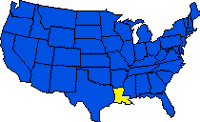 Louisiana is part of a sedimentary plain that slopes gently toward the Gulf of Mexico. The tilted strata that constitute this plain are pierced in the northwest and coastal area by enormous plugs of salt called salt domes. The most pronounced relief in the land surface is found in the northern hills and the area north of Lake Pontchartrain. The flattest terrain is on the coastal marshes. The dominant physical feature of the state is the Mississippi River.
Louisiana is part of a sedimentary plain that slopes gently toward the Gulf of Mexico. The tilted strata that constitute this plain are pierced in the northwest and coastal area by enormous plugs of salt called salt domes. The most pronounced relief in the land surface is found in the northern hills and the area north of Lake Pontchartrain. The flattest terrain is on the coastal marshes. The dominant physical feature of the state is the Mississippi River.
Five natural regions are recognizable. The coastal marshes have a relatively firm underlying surface in saltwater areas to the west and are soft in the irregular freshwater areas to the east. The gently sloping alluvial valley of the Mississippi lies toward the east, with its channels forming a delta shaped like a bird’s foot. The Red River valley, running northwest to southeast, follows the Mississippi’s pattern. The terraces comprise the prairies in the southwest and the flatwoods to their north. The loessial bluffs flanking the Mississippi, containing moderate relief, are also part of the terraces. The hill region, found in the north, is the largest, highest, and oldest part of the state.
Climate
Louisiana’s humid subtropical climate is relatively uniform throughout the state. The chief factors influencing climate are the subtropical latitude, location along the Gulf of Mexico, the continental landmass to the north, and the prevailing southerly winds. Average annual precipitation ranges from 1,175 mm (46 in) in the northwest to more than 1,625 mm (64 in) in the southeast. Although precipitation is for the most part evenly distributed throughout the year, February and March tend to be slightly wetter. Diurnal summer temperatures range from 29 deg to 35 deg C (84 deg to 95 deg F) in the afternoons to 16 deg to 24 deg C (61 deg to 75 deg F) in the early morning. Temperatures of at least 38 deg C (100 deg F) occur in almost all years. Louisiana is subject to tropical storms in summer and hurricanes in summer and fall, often accompanied by tornadoes. The cooler seasons are more variable, influenced by both cold polar air and warm tropical air. Winter temperatures fall below freezing (0 deg C or 32 deg F) every winter.
Tourism
Tourist traffic to Louisiana is served by a number of airlines, four interstate highways, and state and federal roadways. Tourism is generally focused on the metropolitan centers, with New Orleans most important. The city attracts large numbers of Mardi Gras visitors. Some 7.3 million people visited New Orleans World’s Fair between May and November 1984. The Cajun country of the southwest is a popular tourist area, and many flock to the state’s numerous festivals to sample the unique cuisine.
History:
The earliest known Indian occupancy dates to perhaps 10,000 years ago. These people, probably big-game hunters, left little evidence of their habitation. A hunting and gathering economy is thought to have continued until about 2,000 years ago, when farming began. The fertile floodplains were gardened, producing squash, sunflowers, beans, and maize. The Poverty Point site, nearly 1.6 km (1 mi) across, has revealed a highly organized society dating from about 700 BC.
Written accounts after the arrival of Europeans document the decline and disappearance of many Indian groups. A reasonable estimate of the Indian population in AD 1700 would be 15,000, formed of six linguistic groups: CADDO in the northwest, NATCHEZ near the middle Mississippi, Atakapa on the prairies of the southwest, Chitimachan in the Atchafalaya Basin, Muskogean east of the Mississippi, and Tunican in the northeast. Most were sedentary village farmers who also hunted and fished.
Permanent European settlement was begun by France almost 200 years after the Spanish had entered the area. Robert Cavelier, sieur de La Salle, explored the Mississippi downstream to its mouth, and he claimed the entire drainage basin for France in 1682. La Salle’s efforts at colonization failed, but the French continued in their attempt to establish a permanent settlement. Eventually, the colony, which had also failed at BILOXI, moved upstream on the Mississippi to the foot of the Great Raft on the Red River, establishing the first permanent settlement in the Louisiana Territory at Natchitoches in 1714. Colonization proceeded under the direction of Pierre Le Moyne, sieur d’ IBERVILLE and his brother, Jean Baptiste Le Moyne, sieur de BIENVILLE.
The early history of the colony is a tragic one, as the first settlers were ill-suited to the rigors of frontier life. In 1717, France granted a monopoly on commerce to John LAW in order to promote development of the territory. His MISSISSIPPI SCHEME was designed to entice investment in what he claimed was a land of fabulous mineral wealth. The scheme fell apart in 1720, with no financial rewards to the investors, but the territory gained population as a result of Law’s promotion.
German peasants from the Upper Rhine area contributed to the betterment of the region when they began to settle land upstream from New Orleans in the 1720s. Louisiana became a French crown colony in 1731. Plantation-grown crops included indigo, rice, and tobacco; trade was primarily by water, and the few roads ran along the levees. To this day, the arpent system, based on an old French unit of measure approximating 0.35 ha (0.85 acres), is evident in the property lines running back from the streams.
In 1762, Louisiana was ceded to Spain as a result of the French and Indian War, and Great Britain gained control of Florida, which extended to the east bank of the Mississippi. At the same time, Acadians, driven from Nova Scotia by the British, began migrating to Louisiana. The Acadians settled in the eastern prairies around the present site of Saint Martinville and later along the Lower Mississippi and Bayou Lafourche.
The Spanish made feeble attempts to offset the growing French population, but were eventually absorbed themselves. In 1800 they returned Louisiana to France by the Treaty of San Ildefonso. Although Napoleon I originally intended to establish a new empire in America, he sold Louisiana to the United States in 1803. The $15-million LOUISIANA PURCHASE represented about 4 cents an acre. Louisiana became the 18th state on Apr. 30, 1812, comprising the territory south of 33 deg North Latitude, which had been the Territory of Orleans. The rest became the Missouri Territory. Not until 1819, however, were the Florida Parishes and the lands west of the Red River added to form the present state boundaries.
During the WAR OF 1812, British ships moved up the Mississippi River to New Orleans. On Jan. 8, 1815, Gen. Andrew Jackson’s troops defeated the British at New Orleans. The battle ended 15 days after the Treaty of Ghent was signed, ending the war. Jean LAFITTE aided the American cause.
By 1860 the population exceeded 700,000, and a class system based on plantations with slave labor had developed. At the same time, yeoman farmers were practicing subsistence farming–Celtic Scots-Irish in the hills and Acadians in the south. During the Civil War, the importance of the port of New Orleans and Louisianan’s strategic position on the Mississippi made it an early Union target; the state’s economy was devastated.
Streams had been the major routes since the beginning of settlement. By the 1860 peak of steamboat travel, nearly all of the state could be reached by these craft. As railroads improved, steamboat traffic declined. Rail travel grew in the early 20th century. Much of the modern settlement of the prairies is attributable to the access of rail travel. Highway development began after the 1920s. The prairies began to change from the arpent-strip farms of the Acadians (or Cajuns, as they came to be known) and the rectangular Spanish sitio grants for ranching, to vast rice fields farmed by Midwestern migrants who arrived at the beginning of the 20th century.
Louisiana had come a long way from the earliest Spanish explorers and French settlers, through the Civil War and Reconstruction. In 1928 a Winnfield lawyer, Huey Pierce Long, Jr. (see LONG family), was elected governor, and from 1930 to 1935 he served as a U.S. senator. His program of road building and free school books, based on tax revenue from petroleum, appealed to the grass-roots population, but his methods became increasingly suspect. Scandals, which had begun by the mid-1930s, accelerated after Long was assassinated in 1935, but his career marked a turning point in Louisiana history.
For much of the period since World War II the petroleum industry sparked the development of the state (with the notable exception of the oil slump that has taken place since the mid-1980s). Urgent environmental problems that emerged in the 1980s, including industrial pollution, toxic-waste disposal, and coastline erosion, continued into the 1990s. In 1992, Louisiana sustained damage to cropland and several smaller coastal towns from Hurricane Andrew, among the most intense U. S. storms of the century.
Land:
- Area: 134,274 sq km (51,843 sq mi); rank: 31st.
- Capital: Baton Rouge (1990 pop., 219,531).
- Largest city: New Orleans (1990 census, 496,938).
- County equivalents (parishes): 64.
- Elevations: highest-163 m (535 ft), at Driskill Mountain; lowest–minus 2 m (minus 5 ft), at New Orleans.
 Kids Portal For Parents India Kids Network
Kids Portal For Parents India Kids Network
